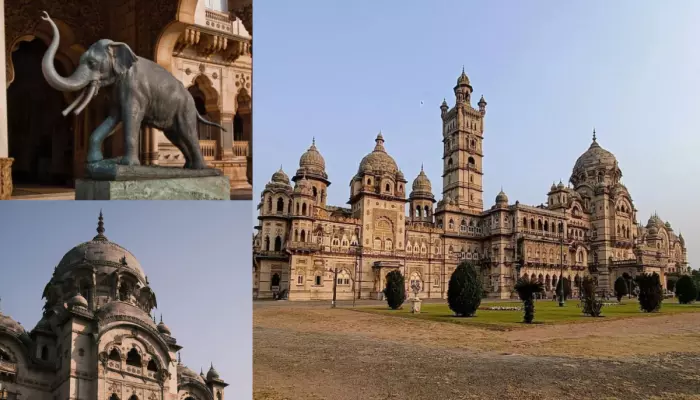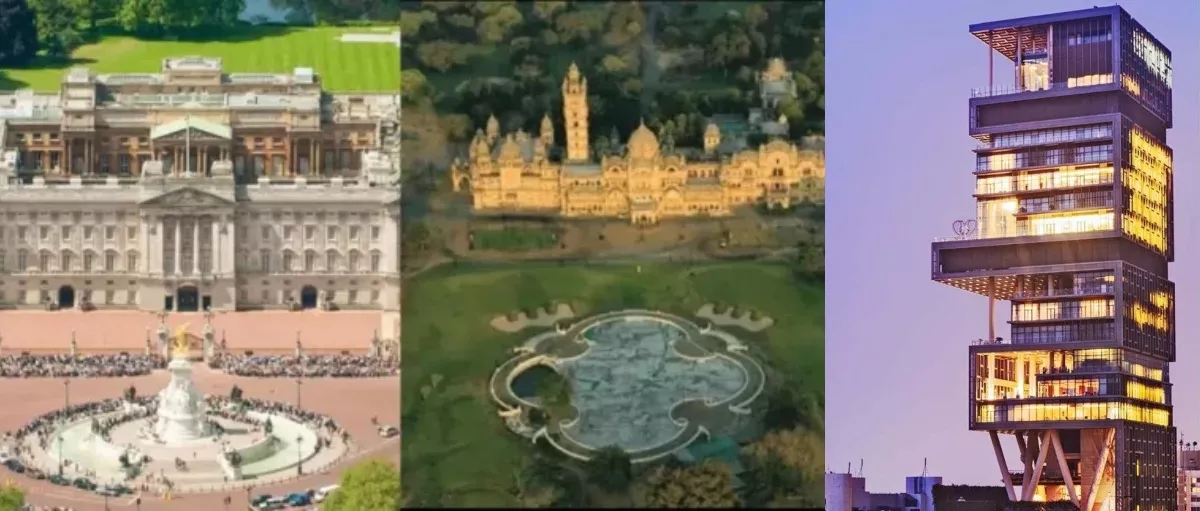

Did you know that India houses a private residence so vast that it could make Buckingham Palace blush? Brace yourselves for this virtual tour of the sprawling mansion that attracts visitors worldwide.

Imagine a palace so vast that it could rival the grandest castles of Europe — a place where culture meets grandeur and testifies to a rich tapestry of heritage worldwide. An architectural marvel that once housed some of the most powerful warriors and welcomed the greatest artists to add to its glory. Now, what if we tell you that this palace is located right here in India?
Sounds too good to be true? Well, let us introduce you to Lakshmi Vilas Palace in Vadodara, Gujarat, the largest mansion ever owned that preserves the extraordinary vision of a monarch and a legacy that continues to awe and inspire.

Nestled amidst the picturesque landscape of Vadodara (Baroda), Gujarat, Lakshmi Vilas Palace stands as a rich cultural heritage of India. Home to the Gaekwad dynasty, the palace once welcomed dignitaries like Aurobindo Ghosh and Raja Ravi Varma. This historic estate spans over 700 acres (30,454,600 square feet), which makes it four times larger than Buckingham Palace housing the Royal Family of Europe (8,28,800 square feet).
The Lakshmi Vilas Palace is nothing short of an architectural marvel and a testament to Major Charles Mant, a prominent British architect of the time. Equipped with modern amenities including an elevator, electricity and an internal telephone exchange, the palace remains unharmed even after over 130 years.
This grand mansion is renowned across the globe for its grandiose structure, vast grounds and luxurious interior design. There is a combined influence of European and Indo-Saracenic styles in the mansion’s architecture. The building’s exterior features golden stones extracted from the Songandh quarries which give it a majestic golden glow.
The European influence is evident from its stained glass windows specially curated by Italian artists, gothic arches and ornate chandeliers scattered throughout the palace. One of its most impressive testaments is iconic the Darbar Hall which features Belgian stained glass windows, ornate Venetial floor mosaic and huge crystal chandeliers. The hall also has a balcony for musicians, reminiscent of European ballrooms, where the royal family would host events and entertain dignitaries.
Aside from this, the architecture largely reflects the Indo-Saracenic influence through its large domes and Mughal-style minarets, intricate balconies and jharokha reflecting Rajasthani architecture and grand courtyards designed to accommodate both traditional Indian rituals and European-style formal gatherings.
The four-story Lakshmi Vilas Palace comprises 170 rooms designed exclusively for the Maharaja and Maharani. Aside from the grand Darbar Hall spanning over 5,000 square feet, palace interiors feature a ‘Gaadi Hall’ and the ‘Pratap shastragar’ (the royal armoury).
The ‘Gaadi Hall’ houses some original oil paintings by Raja Ravi Verma, including renowned works like Saraswati, Lakshmi, and ‘Kans-Maaya’. These paintings, along with other mythological scenes and family portraits, are spread across various rooms within the palace.
Their huge arms collection features several famous weapons including some World War I revolvers, the sword of Shivaji Maharaj, Aurangzeb’s sword, the Nav-Durga sword, a diamond and pearl-studded sword belonging to Sayajirao III, the Panchkula talvar of Guru Gobindshinji and the Abbasi Alemani sword used in the war of Karbala.
Aside from this resplendent building, the royal grounds of Lakshmi Vilas Palace feature lush green lawns, golf courses, specially curated gardens, a badminton court, a tennis court, the Moti Baugh Cricket Ground, the Baroda Cricket Association offices, the Moti Baug Palace, and the LVP Banquets & Conventions. Back in the day, the property also had a small zoo train track on the grounds to transport the royal children throughout the palace. If that doesn’t scream luxury, what does?
The palace grounds also feature one of the largest polo grounds in India along with a stepwell and some other buildings including the Maharaja Fateh Singh Museum and the Palace Library. The Moti Baugh Cricket Ground transforms into a vibrant hub of tradition during Navratri, hosting the ‘Lakshmi Vilas Palace Heritage Garba festival. A highlight of the event is the presence of the Maharani, Radhikaraje Gaikwad who joins the revellers in celebrating with unmatched enthusiasm.
The history of the Gaekwads dates back to the rule of Pilaji Rao Gaekwad, who established his authority in Vadodara in the early 18th century. The title ‘Gaekwad’ originated from a time when the dynasty’s early rulers, members of the Suryavanshi clan, saved numerous cows (gae) from slaughter by bringing them into the palace and securing them to the doors (kaiwari). This compassionate act led to the adoption of ‘Gaekwad,’ as the title which signifies a ‘defender of cow protection’.
Lakshmi Vilas was constructed under the rule of Maharaja Sayajirao Gaekwad III who was popular for his active participation in educational reform, modernising his kingdom and supporting infrastructure development in Baroda. The grand residence was completed in 1890 after 11 years of hard work and cost approximately 180,000 British Pounds (approximately INR 1.98 crore), a staggering amount back in the day.
Today, years after the end of the monarchy, the Gaekwads continue to hold a special place in the heart of Vadodara for their immense contribution to society and universal education. The Maharaja Sayajirao University, set up by the same ruler, remains a prominent educational institution in Vadodara, which is run solely by the family’s women.
The current head of this royal lineage is Samarjitsinh Gaekwad, who was coronated in 2012 after the death of his father, the late Ranjitsinh Pratapsinh Gaekwad (1988-2012). He and his wife, Radhikaraje Gaekwad currently reside in Lakshmi Vilas along with his mother and two daughters.
Ready to be blown away by the Lakshmi Vilas Palace? Parts of this massive mansion are open to the public, so you can see the Darbar, the shastragar, and the Gaadi Hall up close. So, when are you visiting?
Also Read: Inside Kunal Nayyar And Neha Kapur's USD 7.5M Los Angeles Home, Tudor Escape With Modern Luxury